Egyptian Mythology is incredibly ancient and complex. It lacked a central authority, with major cities and areas having their own important gods. Myths often got mixed up, with gods having different roles, being combined with others to form new composite gods, and different family relationships as old gods fell into obscurity and new gods rose to prominence.
In General
- Amazing Technicolor Population: The fully humanoid gods often had green or blue skin.
- Blue-and-Orange Morality: They worked on an 'order vs chaos' mentality where chaos, no matter how well-intentioned, would cause destruction while order would lead to prosperity.
- Food God: Hathor and Renenuet, with the latter being the general harvest and Hathor representing plenty.
- God of the Dead: Anubis, Osiris, Nepthys, Seker, Nehbebkau, and Wepwawet. Various other goddess, including Hathor, were said to protect the dead, and Medjed had some role in the process.
- God of Light: A lot of solar deities, as expected of a desert country. Ra was the best-known one, but others include Atum, Sekhmet (specifically the harsh, burning sun), Montu, Pakhet, Khepri, and Mut. Even Sobek, normally a river god, took a turn as a solar god when he was syncretized with Ra or Horus.
- God of the Moon: Usually Khonsu, but Horus was also sometimes one; he had one of his eyes gouged out by Set, and his original eye represented the Sun while his Isis-made replacement represented the moon.
- God of Order: All of them. Egyptian cosmology divided the world into 'order' and 'chaos', where order was the side that kept things working and chaos (usually represented by Apep and/or Set) was the side that tried to break it.
- Little Bit Beastly: They were often, though not always, portrayed with traits of animals they were associated with, though level of anthropomorphism varied. The most common variety was 'normal human with the head of an animal'.
- Lord of the Ocean: No ocean god, but plenty of deities associated with water and rivers, thanks to the Nile. This category includes Hapi (god of the Nile's annual flood), Neith, Nepthys, Khnum (more specifically, he was river mud), Tefnut (rain and moisture), and Sobek.
- Love Goddess: Hathor was the primary love goddess, but Babi and Sobek were gods of male fertility, and Tawaret of female fertility.
- The Maker: Atum, Ptah, Neith, and occasionally Khonsu and Hathor. Khnum was also sometimes considered to have made the other gods by sculpting them out of river clay.
- Stock Gods: A very confused case. Because the Egyptian religion varied so much over time and between various cities, multiple gods often covered various popular domains, often with contradictory stories.
Primordials
Ὀγδοάς | Ogdoad note

- Alternate Company Equivalent: To Tiamat and Abzu, as well as Khaos/Chaos and the Protogenoi.
- Dark Is Not Evil: Kek's name meant "darkness", and he was part of the benevolent Ogdoad, where he represented both the primordial darkness and the bringing of dawn.
- Depending on the Writer: The fourth pair of male and female deities wasn't consistent and varied between Amun and Amunet or Qerḥ and Qerḥet.
- Eldritch Abomination: Every one of them qualifies, though sometimes they are depicted as either humanoid or animalistic.
- Flat Character: None of them had much in the way of characterization or individual stories, and only Amun (when he was included in the Ogdoad at all) became prominent enough to be worshipped separately. This is a given seeing as they are simply primal forces with no characterization and little surviving documents.
- Frog Men: The male gods (Nenu, Ḥeḥu, Kek, and Amun or Qerḥ) were often portrayed with frogs' heads, while the female gods (Naunet, Ḥeḥut, Kauket, and Amunet or Qerḥet) were depicted with serpents' heads. This was in keeping with their creation myth, where they lived in the primordial waters of the universe and therefore took the forms of water-dwelling creatures.
- Hermaphrodite: Nenu and Naunet, while the others are gender-flipped.
- Inconsistent Spelling: Their names could be spelled in plenty of different ways. Nenu's name was often spelled as "Nu" or "Nun".
- Light/Darkness Juxtaposition: Kek and Kauket are deities of both these domains.
- Primordial Chaos: Nenu and Naunet represented the chaotic, cosmic ocean of Nu that was believed to shape the universe.
- The Old Gods: These are what the Egyptians worshipped before the Ennead replaced them.
- Time Abyss: Double points for this being the case both in Real Life and In-Universe, er- mythology. They are from the oldest surviving records and are the first deities in the whole Egyptian mythos.
𓏏𓍃𓀭 | Atum/Atoum/Atem/Tem note

- Composite Character: He was often fused with Ra, as both were Top Gods associated with the sun. Sometimes he was said to be Ra's aspect that represented the evening sun, while Ra and Khepri represented morning and midday, respectively.
- Depending on the Writer: It was never really consistent as to how he created his children. The myths varied over whether he did it by breathing and spitting, masturbating, or by copulating with his own shadow.
- God of Light: He was a solar god who represented the evening sun, and was sometimes considered an aspect of Ra.
- The Maker: One of several in this pantheon.
- Papa Wolf: When Shu and Tefnut went into the primordial waters of the universe to explore them and disappeared, he sent the fiery Eye of Ra to retrieve them.
- Tears of Joy: He shed tears of happiness when the Eye of Ra returned his lost children to him. Said tears were claimed to turn into the first human beings.
- Truly Single Parent: In most myths, he created Shu and Tefnut on his own by either masturbating or spitting. Some claimed he mated with his shadow instead.
𓈙𓆄𓅱𓀭 | Shu note

- Adam and Eve Plot: All the other deities, humans and creatures are descendant from him and his sister.
- Blow You Away: He was the god of air and wind.
- Brother–Sister Incest: With Tefnut.
- "Just So" Story: The story of him preventing Geb and Nut from meeting each other is used to explain why sky is separate from land.
- King of Beasts: He is the god of male African lions, though unlike his sister/wife he isn't portrayed with an animal head.
- Parental Marriage Veto: He does not approve his children Geb and Nut from marrying each other, and literally keeps them apart by standing between them
 ◊. They manage to conceive several children before being separated forever.
◊. They manage to conceive several children before being separated forever.
𓏏𓆑𓈖𓏏𓆘 | Θέφνις | Tefnut note

- Adam and Eve Plot: All the other deities, humans and creatures are descended from her and her brother.
- Brother–Sister Incest: With Shu.
- Cats Hate Water: Inverted; she's a lion goddess associated with moisture.
- King of Beasts: She is the goddess of female African lions and is depicted with a lioness head.
- Making a Splash: She was the goddess of moisture, dew, moist air and rain.
𓊪𓏏𓎛𓀭 | Φθά | Ptah note

- Animal Motif: Bulls.
- The Magnificent: He bears plenty of epithets that describe his role in ancient Egyptian religion and its importance in society at the time, such as "the beautiful face", "the lord of truth and eternity", "the master of justice and ceremonies" and "the one who listens to prayers".
- The Maker: He's another creator god, though a less squicky one than Atum.
- The Power of Language: In the myths which see Ptah as the creator deity, he conceives reality by thinking it and speaking it aloud.
- The Sacred Darkness: He has elements of a chthonic deity, through his association with the underground and the afterlife. Notably, out of the four statues of gods in the Sanctuary of the Great Temple at Abu Simbel, Ptah's is the only one which always remains in shadow during the days when the sun rays align with the temple's axis.
𓏏𓈖𓋌𓁐| Νηΐθ | Neith/Nit/Net/Neit note

- Animal Motifs: While she’s usually not depicted with an animal head like a lot of the other Egyptian gods, Neith was often associated with spiders due to being known as “the great weaver” who weaved the threads of creation like a spider weaves its webs.
- Depending on the Writer: The myths varied over time as to whether she was just a river goddess or a creator deity responsible for making the universe. She was originally often worshiped as the latter in the Old Kingdom period, but this aspect of her mostly faded out when Ra took center stage as the Top God. She was sometimes said to be married to Khnum or Ptah, and her children also varied; Sobek and Serket were attributed to her, as were Ra and Apep.
- The Maker: Early myths depicted her as a creator goddess who wove the universe into existence from her loom. She was also occasionally portrayed as the mother of Ra and Apep, the embodiments of light and darkness.
- Master of Threads: Due to her symbol being a loom, the Greeks dubbed Neith a goddess of weaving during the syncretisation of Greek myths to Egyptian ones.
- Renaissance Man: The description above is a good indicator that she had power over plenty of domains. Granted, she is a goddess.
- Textile Work Is Feminine: Is the goddess of mothers and childbirth, as well as weaving.
- War God: This is another of her many aspects. She was often depicted carrying a bow and arrow into battle, and her symbol was a shield with two arrows over it.
- Women Are Wiser: Also is a goddess of wisdom, among other things.
𓅭𓃀𓀭 | Geb/Seb/Keb note
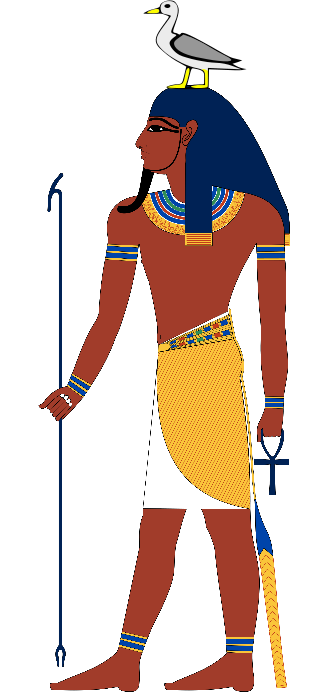
- Brother–Sister Incest: With Nut.
- Dishing Out Dirt: He represented the soil of the earth and its bountiful produce.
- Disturbed Doves: Geese are his sacred animals and he is depicted with one standing on his head. Therefore whenever geese flew away, the ancient Egyptians thought something bad was happening with the Earth.
- Father Nature: He represented the earth, making him the male Egyptian version of Gaia (and one of the few male deities to represent nature in general).
- Green Thumb: Also the god of nature and vegetation.
- Snakes Are Sinister: Averted. He was sometimes associated with snakes, due to one Coffin Text describing him as the father of snake god Nehebkau, but he was a benevolent deity.
- Star-Crossed Lovers: He and Nut were separated by their parents, Shu and Tefnut, so that life could exist on the earth. This served as the "Just So" Story for why the sky and the ground were far apart.
𓏍𓇯𓈗𓀭 | Nenu/Nut/Nunut/Nent/Nuit note
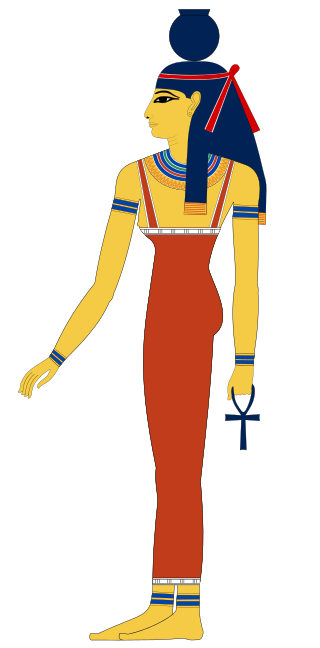
- Amazing Technicolor Population: She is depicted with dark blue skin to represent the skies.
- Brother–Sister Incest: With Geb.
- Celestial Body: Possibly the Ur-Example, she has stars drawn on her "skin" [1]
 .
. - Leg Focus: A justified example, her long and slender proportions create a dome which symbolizes the sky and cosmos above the Earth.
- Longest Pregnancy Ever: Because Ra feared that her and Geb's children would overthrow him, he forbade her from giving birth on any day of the year. She was stuck with this kind of pregnancy until she went to Thoth, who gambled with Khonsu for moonlight to make four (or five) days for her to give birth to her children: Osiris, Set, Isis, and Nephthys (and, depending on the version, Horus).
- Star-Crossed Lovers: She and Geb were separated by their parents, Shu and Tefnut, so that life could exist on the earth. This served as the "Just So" Story for why the sky and the ground were far apart.
𓇋𓏠𓈖𓁩 | Ἄμμων | Amun/Amon/Ammon/Amen note

- Amazing Technicolor Population: He was sometimes portrayed with blue skin, usually in the Amun-Ra persona.
- Bed Trick: To legitimize her rule as Pharaoh, Hatshepsut claimed that she was Amun's daughter by way of him disguising himself as her father, Thutmose I, to sleep with her mother.
- Breakout Character: He was originally just another member of the Ogdoad, but eventually rose in individual importance to become the patron god of Thebes, which was the capital during the Eighteenth Dynasty period, and a Top God who ruled the pantheon.
- Composite Character: He was combined with Ra into the deity Amun-Ra, as well as Zeus.
- Top God: He was the patron deity of Thebes, which was Egypt's capital during much of the New Dynasty, and was thus seen as this for a time (especially as Amun-Ra).
Major Deities
𓂋𓂝𓇳𓏤𓁛/𓇳𓏤𓁛/𓁛𓇳 | Ra/Rênote

One of his aspects was the sun disc Aten, which became the principal deity under the reign of Akhenaten (to the woe of the Amun-Ra clergy). After his death, worship of Ra was made central again. As the Top God for thousands of years, Ra was often combined with other deities like Amun and Atum; such combined forms were known as Amun-Ra and Atum-Ra. He had many other names, with each part of the sun or time of day of the sun often having its own name.
The most common myth about him was that he sailed across the sky in a solar barge during the day and through the underworld at night. Though he always brought the sun's warmth, he battled every day and night with the Eldritch Abomination, Apep (Apophis), to prevent him from ending the world. Ra was seen as a benevolent deity who embodied the positive traits of the sun, but was also aloof and above involving himself in the other gods' squabbles.
- Amazing Technicolor Population: His Amun-Ra form was portrayed with blue skin after the Amarna Period.
- Animal Motifs: He was usually depicted in artwork as a man with the head of a falcon, a scarab (in his form as Khepri), a cat (especially when in contrast with the snake demon Apep), or a ram. He was also pictured as a full-bodied ram, beetle, phoenix, heron, serpent, bull, cat, or lion, among others.
- Arch-Enemy: He was this to Apep. The serpent came into being from Ra's umbilical cord after the sun god's birth, and the two spent the rest of their lives in constant struggle, Apep seeking to destroy the world while Ra fought to prevent this.
- Big Good: Ra's existence ensures the existence of light and life. Reality couldn't exist if he died because he's the only God who's protecting reality by fighting Apophis at a daily basis.
- Cain and Abel: He and Apep were said to come from the same umbilical cord, though some other myths held that they originated from the same primordial waters of the universe instead.
- Composite Character: He and Amun would often be combined into Amun-Ra, especially during the New Kingdom Period. He was also occasionally conflated with Atum or Horus; the shared form of Ra and Horus was called Ra-Horakhty.
- Disproportionate Retribution: His response to the insufficient respect from his followers was to order Sekhmet to massacre humanity. He only backtracked when Sekhmet was too bloodthirsty about it and stopped her by having Thoth trick her into drinking red beer that she mistook for blood.
- Distaff Counterpart: His female aspect was Raet-Tawy, who was sometimes considered a wife of Montu.
- Divine Incest: Hathor was considered his mother, wife, and daughter all in one, which symbolized the cycle of rebirth as the sun rose and set each day because she was a sky goddess and he was a solar god.
- Eaten Alive: If Apep ever got the drop on him during their never-ending battle, he would end up as this and the result was seen as a solar eclipse. However, just like how the sun always emerges from an eclipse, Ra would always escape afterwards.
- God of Light: He was the embodiment of the sun in the pantheon and was seen as the "main" solar deity, especially during the New Kingdom.
- The Good King: Occasional genocidal tantrums aside, he was worshiped as the benevolent king of the gods and the great source of light and life.
- Jerkass Gods: At his worst. He sent Sekhmet on a murderous rampage against humanity solely because they weren't respecting him enough, and only ended it because he thought she was overdoing it.
- Light 'em Up: As the god of light, he was associated with the sun and used boats known as Solar Barques to travel.
- Light Is Good: He's the God of the Sun, and the protector of reality. That said, he also has a bit of a dark side, such as when he sent Sekhmet to destroy mortals who were conspiring against him.
- Noble Bird of Prey: He was often portrayed with a falcon's head, and was worshiped as a king who defended the world from the monstrous Apep by doing battle with him on a solar barque every day and night.
- The Power of the Sun: He was thought to embody its positive, life-giving qualities and traveled on a solar barge.
- Shapeshifter: During dawn and the morning hours, he's depicted as a Scarab who pushes the sun upwards; at noon; he becomes the iconic eagle-man, and finally, at dusk, he becomes the more human Atum, the God of the setting sun.
- Top God: Naturally, as king of the gods. After Isis' coup, he remained king of the heavens but ceded the Earth to Horus, and concentrated his efforts on the battle with Apep.
- You Can't Fight Fate: He tried to avert a prophecy that a child of the sky goddess, Nut, would be evil, by forbidding her from having children on any day of the year. Thoth gambled with the moon and won moonlight to create five extra days so Nut could give birth anyway (hence why the Egyptian calendar had twelve months of 30 days even, and an extra thirteenth month of just five days). In the end, Nut's children, particularly Isis, did end up usurping him.
𓉡 | Ἁθώρ | Hathor/Hut-hor note
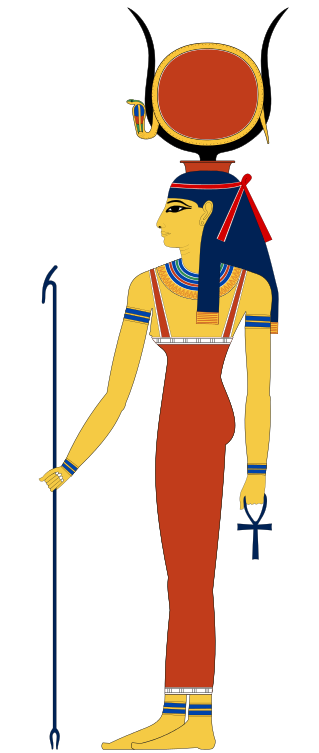
- The Almighty Dollar: Considered a wealth goddess because of her association with mineral wealth (gold, copper, precious stones), plenty to eat (cattle Food God currency), and abundance festivals. She also gained an association with trade with foreign lands. Another case where Love Goddess overlaps with wealth/money power.
- Animal Motifs: Often pictured in the form of a cow, or a human with cow ears.
- Beware the Nice Ones: Her other avatar is the bloodthirsty Sekhmet.
- Composite Character: A strange case; she seems to have absorbed aspects of other goddesses because she was favoured under the Old Kingdom court, making her an out-of-universe example of The Assimilator as well. This is probably one of the reasons some texts speak of "Seven Hathors" (and sometimes of many more versions of her - as many as 362). In particular, she is known to have absorbed aspects of Bat and an early crocodile god who was worshipped at Dendera. She was also occasionally combined with Isis, another goddess associated with motherhood.
- Depending on the Writer: Even more so than other Egyptian deities, some aspects of her characterisation (such as who her consort(s) is/are) vary pretty widely from myth to myth, probably because she's a Composite Character. Some tellings also have her involved in creating the world itself in some role or other.
- Divine Incest: She was considered Ra's mother, daughter, and wife all in one to symbolize the cycle of rebirth as the sun rose and set each day, in keeping with her status as a sky goddess and his as a sun god. She was also considered both Horus's mother and consort, depending on whether or not she was combined with Isis.
- Fun Personified: She's the Hot Goddess of joy, music, and booze. Basically, she's the goddess of parties.
- Going Commando: May have made a habit of doing this, as one anecdote (described below under Lovable Sex Maniac) has her flashing her genitalia at Ra.note
- Good Bad Girl: As long as she isn't in her Sekhmet guise, anyway. One surviving text compares the goddess Mut to a faithful wife and Hathor to a strange woman who tempts a married man, but Hathor is unambiguously good (as long as she hasn't turned into Sekhmet).
- Hard-Drinking Party Girl: As humorously summed up by Stargate SG-1:Daniel Jackson: Hathor was the Egyptian goddess of fertility, inebriety, and music.
Jack O'Neill: Sex, drugs, and rock n' roll?
Daniel Jackson: In a manner of speaking. - Healer God: She was occasionally associated with healing. One tale told of how she healed Horus's eyes, which had been gouged out in a fight with Set, by pouring gazelle's milk onto them.
- Hot Goddess: The goddess of beauty and love.
- Interplay of Sex and Violence: Depending on her form she is either a bloodthirsty destroyer or a Hard-Drinking Party Girl.
- Jekyll & Hyde: She's a sweet, motherly cow deity whose alternate form is the savage lioness goddess Sekhmet. Some versions of the Sekhmet myth posit that the "Hyde" personality was the original one and Hathor came into being as Sekhmet's alter-ego (because Sekhmet was changed into a cow while sleeping after drinking blood-red beer) instead of the other way around.
- Launcher of a Thousand Ships: An In-Universe example. She's been paired off with almost every major god in the Egyptian pantheon in different versions of the mythology, though she was most popularly associated with Horus and Ra.
- Lovable Sex Maniac: Often comes across this way. In one story, Ra was feeling upset after an insult by another god, Babi, and lied on his back alone; Hathor managed to get him to return to his duties as ruler of the gods by flashing her genitalia at him, which sexually aroused him and, for some reason, made him laugh. Order and life were said to be dependent upon Ra's actions, and Hathor thus averted a catastrophe.
- Love Goddess: She was worshiped as the goddess of love and the epitome of feminine beauty in Egyptian culture.
- The Maker: A Depending on the Writer example. Some tellings give her the role of the Hand of Atum, which makes her instrumental in the creation of the world; other tellings give that role to Nebethetepet or Iusaaset. In yet another telling from the Ptolemaic Period, the world results from a coupling between Khonsu and Hathor.
- Really Gets Around: Like several of the other Egyptian pantheon. She had children or was romantically or sexually linked with several different deities, including Ra, Montu, Khonsu, Atum, Amun, Horus, and Shu. She is also more frankly sexual than the other Egyptian goddesses of love or motherhood. That said, Hathor may also be a Composite Character in a sense, as she may have subsumed a number of other goddesses who became regarded as manifestations of Hathor - a number of Egyptian texts actually speak of "Seven Hathors", or less commonly of even more (as many as 362, in fact). As a result, Egyptologist Robyn Gillam refers to her as "a type of deity rather than a single entity", where each specific deity may not have been that promiscuous.
- Sex Goddess: Beyond literally being the goddess of sex, there's also plenty of textual evidence suggesting that she was quite skilled in bed.
- Shameless Fanservice Girl: Judging from the anecdote under Lovable Sex Maniac. She had a pragmatic reason for her actions too, though (namely, preventing the cosmos from falling into chaos).
- Superpowered Evil Side: When she becomes Sekhmet, she becomes a bloodthirsty maniac hell-bent on killing everyone in her way.
- Tsundere: A particularly severe example, as she is normally joyful, fun-loving, and affectionate, but saying she has a severe temper is an understatement; her dark side is the Omnicidal Maniac Sekhmet. Egyptians made offerings to her to keep her temper in check, and various mythological texts note that the gods and goddesses played music and danced for her for the exact same reason. Egyptologists hold that the dichotomy between Sekhmet and Hathor illustrates ancient Egyptians' conception that femininity, in Carolyn Graves-Brown's words, "encompassed both extreme passions of fury and love," probably better than any other goddess does.
- You Can't Fight Fate: Possibly averted. She is associated with fate, particularly in stories involving the "Seven Hathors", and ancient Egyptians tended to think of fate as inexorable, but the fates she foretells merely seem to be possible readings of the future. "The Tale of the Doomed Prince" only survives in fragments, and its ending is missing, but the surviving segments show that the titular prince escapes one of the possible violent deaths the Seven Hathors have foretold for him and suggest that he may be able to escape his fate entirely with the gods' help.
𓊨𓁹𓀭 | Osiris/Wesir note
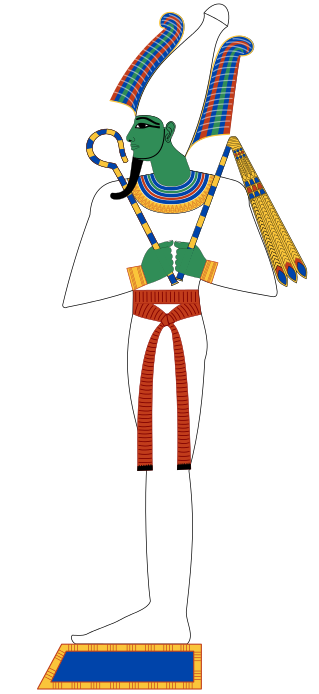
Osiris is the god of the afterlife, of the fertile vegetation of the Nile valley, and of resurrection and rebirth. He is the son of the primordial earth god Geb and sky goddess Nut, along with his siblings Isis, Nephthys, and Set. Along with his Isis and Anubis, he oversees the weighing of the heart and lets souls enter the afterlife if they pass the test. He is a very prominent example of a Life-Death-Rebirth god. He was the king of Egypt after his father Geb (or in other versions Ra) stepped down. Set tricked him into entering a coffin and killed him by throwing him into the Nile. When his wife Isis managed to find the body, Set tore it apart, scattering his pieces across Egypt. His pieces were found and he was eventually resurrected thanks to the efforts of Isis and Anubis. Yet, because he had died, he stayed in the land of the dead, becoming its ruler.
- Adaptational Heroism: In earlier myths he's not as benevolent as in the Osirian cycle, which made him The Good King to emphasize Set's villainy for killing him.
- Animal Motif: He was sometimes associated with frogs because the frog goddess Heqet breathed life into Horus's body when he was born, and thus also Osiris's body when he was resurrected. Other times, he was associated with the Bennu (a gray heron-like bird that represented the sun) to symbolize his rebirth.
- Amazing Technicolor Population: Has greenish skin in most artwork, representing his dominion over life and fertility.
- Back from the Dead: As a result of Isis' magic ritual, he was resurrected and was thus able to conceive Horus with her. Because his body had died, however, he remained in the afterlife and ruled there from then on.
- Brother–Sister Incest: His wife Isis is most commonly also his sister.
- Cain and Abel: He was The Good King who was murdered by his treacherous brother, Set.
- Came Back Wrong: Sort of. He was able to return to life because of Isis's rituals, but he had to reign over the underworld from then on because he could only be revived as an undead being.
- Dark Is Not Evil: He ruled the afterlife after his death, and was as benevolent there as he was in life.
- Destination Host Unreachable: After being murdered by Set, Osiris was resurrected twice but couldn't stay in our world either time. The first time, he died almost immediately after having sex with Isis and impregnating her with Horus. The second time, he was shuffled off to the underworld to rule over the dead. This wasn't such a bad deal for him, though, as in Egyptian mythology the underworld is a pretty nice place, more akin to heaven than to other mythological underworlds. And Osiris stayed a powerful god and was venerated by the people of Egypt as one of their chief deities.
- Disappeared Dad: Due to being killed before Horus's birth and resurrected for only a brief time to conceive him with Isis, he was this for Horus and had next to no involvement with his upbringing.
- Dismembering the Body: His body was torn apart and scattered across Egypt after Set killed him; to resurrect him, Isis had to find all the pieces and reassemble them.
- Distressed Dude: The Ur-Example. A central point of Egyptian mythology is the story of Isis having to rescue him (and resurrect him with the help of Anubis) after he had been killed by Set.
- God of the Dead: He was the main god of the dead, ruling over the spirits of the virtuous in the afterlife of the Field of Reeds.
- The Good King: He was a benevolent king whose reign brought prosperity to Egypt while he was alive.
- Groin Attack: Set not only cut him into fourteen pieces, but also fed his penis to a catfish. In order to conceive Horus, Isis crafted him a prosthetic one from solid gold.
- Happily Married: He and Isis were worshiped as the ideal husband and wife when the Horus cult was in power.
- Inhuman Human: Maybe, as he's usually portrayed as a blue- or green-skinned mummy after his resurrection. He was still able to impregnate Isis, though.
- Life/Death Juxtaposition: He is both a fertility god ("Lord of the black Sands", referring to the fertile, black mud that the Nile left behind each time it flooded) and the ruler of dead while being Not Quite Dead himself.
- Noodle Incident: Osiris's murder was a taboo subject in the original Egyptian texts, due to the belief that written words could affect reality and writing about a topic as grave as Osiris's death would thus bring great misfortune. Because of this, his murder was only alluded to or implied, and how Set killed him is never described clearly (the myth about Set tricking Osiris into getting in a coffin that he sealed shut is strictly a Greek adaptation by Plutarch). The texts implied that Set either drowned Osiris in the Nile or took the form of a crocodile or bull to kill him.
- Scales of Justice: Although he's depicted with them less often than Anubis, Osiris is often shown in art presiding over the Weighing of the Heart ceremony, during which Anubis uses the Scales of Ma'at to weigh the deceased's heart against the Feather of Ma'at.
- Too Dumb to Live: In the myth where he had an affair with Nephthys, he comes off as this for blindly trusting Set and getting into the coffin that Set uses to kill him.
𓊨𓏏𓆇𓁐 | Ἶσις | Isis/Aset note

- The Archmage: The only god who could compete with her based on sheer breadth and power of spells was Thoth.
- Animal Motifs: Quite a few animals were asscociated with her. Note that they're all often creatures considered vile in western cultures.
- Birds of prey: Vultures, which were sacred to her, and she was often wearing a vulture crown
 in her depictions. She's also often drawn with hawk's wings in place of arms.
in her depictions. She's also often drawn with hawk's wings in place of arms. - Scorpions: She tends to be accompanied by them due to the association of nurtering their babies. One time she and Horus were guarded by seven of them one time when travelling.
- Snakes, whether wearing a crown based off one or making one out of mud to scheme against Ra.
- Birds of prey: Vultures, which were sacred to her, and she was often wearing a vulture crown
- Bitch in Sheep's Clothing: At her worst. Even though she still presented as a benevolent goddess, Isis convinced Ra to tell her his secret name by poisoning him and waiting for him to be too overwhelmed by agony to refuse. She was also depicted as deceitful and manipulative.
- Breakout Character: Isis has the distinction of remaining incredibly popular even after worship of the Egyptian gods waned in the face of Hellenization. She was originally a consort goddess to Osiris who played a supporting role in his resurrection, but became a major goddess (sometime even a Top God for a long period of time) when the Horus cult rose to power. She also had many temples in her name in Greece, where she had her own epithets (Isidoros and Isidora), and her cult extended to Rome for centuries.
- Brother–Sister Incest: With Osiris.
- Composite Character: She was often combined with Hathor, Serket, and Nekhbet, taking several aspects from them (motherhood, healing, and protection).
- The Coup: After forcing Ra to tell her his secret name, she forced him to step down so Horus could assume the throne.
- God of Knowledge: She was usually considered the goddess that governed Heka, the Ancient Egyptian system of magic. She later became much more powerful after forcing the sun god Ra to reveal his true name to her.
- God Save Us from the Queen!: She was either this or The High Queen, or both, depending on the myth. She had a manipulative and ruthless streak of her own, as shown by the story where she poisoned Ra to force him into telling her his true name to receive her healing.
- Happily Married: She and Osiris were held as the ideal couple when the Horus cult was in power, and the great efforts she undertook to bring him back to life after Set killed him proved how much she loved him.
- Healer God: She was known for her healing magic, which included reviving Osiris and curing the son of a noblewoman who insulted her of his scorpion stings.
- The High Queen: She was also Osiris's benevolent consort and Horus's queen mother, who was revered as a loving maternal figure by the Egyptian people. This was best exemplified by the story "Isis and the Seven Scorpions", where she not only forgave a rich noblewoman for insulting her and refusing her shelter (as Isis had been in a beggar's guise), but also healed the woman's son when he was poisoned by the eponymous scorpions as revenge against the noblewoman. Compare that to, say, the Greek gods, who had many stories where they killed mortals for similar transgressions.
- I Love the Dead: With Osiris' corpse, though she also brought him back to life.
- I Will Find You: She had to search for Osiris's body twice (once when he was killed by Set by way of being thrown into the Nile in a coffin, and again when Set tore his body into pieces and scattered them across Egypt).
- Lady of War: She was a regal and graceful mother goddess, as well as a powerful magic user who wielded many spells and fought fiercely to protect her son from Set.
- Losing Your Head: After accidentally disrupting a fight between Horus and Seth, thus causing the fight to be declared null, Horus beheaded her in a fit of rage. Thoth gave her a cow's head to replace it, serving as the explanation for why Isis was a Composite Character with Hathor in some myths.
- Mama Bear: She went to great lengths to make Horus king and protect him from Set.
- Manipulative Bitch: In one story, Isis secretly sent a snake to poison Ra. While he was in pain, she bargained for him to give her his true name and to let Osiris be his heir. Ra reluctantly complied.
- Necromantic: Using spells taught to her by Thoth, she resurrected Osiris and Horus, though the former was only long enough for them to conceive.
- Not What It Looks Like: In one myth, after one of Osiris' deaths, his coffin was sealed inside a pillar in a noblewoman's house. Isis posed as a nurse to the woman's child to get close to her husband, and grew fond of the boy. One day the mother found Isis had set her son on fire and snatched him away... but those flames would have made the kid immortal, and now he was just like any other child.
- Scales of Justice: Is sometimes depicted assisting during the Weighing of the Heart ceremony.
- Scary Scorpions: Averted. Isis was associated with scorpions, but she was one of the more benevolent deities, and the association is likely to have originated from female scorpions' carrying their young on their backs to defend them, corresponding to Isis' role as a mother figure and her own protection over baby Horus.
- Undying Loyalty: She was defined by her intense loyalty as Osiris's wife through the lengths she went to in order to resurrect him.
𓇓𓏲𓏏𓄡𓃩𓀭/𓋴𓏏𓈙/𓊃𓏏𓄡 | Set/Seth/Sutekh note

- Animal Motifs: We're not sure what animal, though
 . Possibly an aardvark, otherwise it's just called the 'Set animal'.
. Possibly an aardvark, otherwise it's just called the 'Set animal'. - Angry, Angry Hippos: The red hippo is one of the animals associated with him. In one of the myths concerning his rivalry with Horus, they both turned into hippos and fought one another bloodily.
- Adaptational Villainy:
- He was originally a protective deity who defended Ra from Apep, but was gradually demonized when Egypt split into Upper and Lower sections (and as the Horus cult gained in popularity). He was fully cemented as a God of Evil after the Third Intermediate Period, when Egypt was ruled by foreigners who favored the worship of Seth.
- Modern pop culture often ramps up his villainy and associates him with Apep, even though he opposed Apep just as much as the other gods did.
- Archnemesis Dad: He was enemies with his son/nephew Anubis, who sided with Osiris over him. Although they rarely had much actual interaction in the myths, one story in the Jumilhac Papyrus recounted how Anubis stopped him from using a leopard form to attack Osiris's body by flaying him and taking his skin. Because of this, priests usually wore leopard skins to commemorate Anubis's victory over Set.
- The Beastmaster: He's associated with many animals, including jackals, hippos, snakes, wild boars, crocodiles, asses, and antelopes.
- Big Bad: He's the main villain of the Osiris myth, where he kills Osiris, takes this throne, and drives Isis into exile until Osiris and Isis's son, Horus, grows up to challenge him.
- Brother–Sister Incest: With Nephthys.
- Cain and Abel: The Osiris myth depicts him as a treacherous villain who murders his brother, Osiris, and usurps his throne.
- Cartoon Creature: No one really knows which animal his head was supposed to represent. Either it was completely made up, or the depiction was stylized until it became unrecognizable. Theories include some kind of canine stylized to prevent confusion with Anubis, a donkey, a hyena, or an animal that's now extinct.
- Dark Is Not Evil: Pre-demonization, he was still a destructive deity of desert and storms. The folk religion practiced by commoners in rural areas had a tendancy to view him this way even when city-folk demonized him. For what it's worth, modern Kemetics tend to go with this earlier interpretation.
- Demonization: Set was portrayed as a good guy in the older myths. Despite his sneakiness, Egyptians still recognized that he was Ra's chief protector against Apep during his journey through the underworld. However, he became increasingly demonized after the end of the New Kingdom period, as Egypt came to be ruled by foreigners (a domain of Set). By the Late Period, he had pretty much taken over Apep's role as the Big Bad of the Egyptian religion.
- Demoted to Extra: Set was originally the central god of his own cult in the Egyptian religion. The Horus myth, in which Set loses the kingship to his nephew, Horus, is theorized by some to explain how the cult of Horus triumphed over the cult of Set.
- Depraved Bisexual: He tried to humiliate Horus by raping him, and in one myth he tried and failed to rape Isis in the form of a bull (she escaped by turning into a bird and flying away).
- Disproportionate Retribution: One version of the Osiris myth, listed in the Pyramid Texts, put forward that the reason Set killed Osiris was because the latter kicked him once.
- Early Personality Signs: Some texts claim that he violently tore his way out of his mother Nut's womb because he was too impatient to wait to be born, signifying his villainous nature from birth.
- Even Evil Has Standards: He hated the vile Apep as much the other gods. So much so, he helped Ra defeat him every night.
- Evil Redhead: Was often depicted as one in Egyptian art as his followers were red-haired. Red is also associated with the desert in Ancient Egypt, which is one of the domains of Set.
- Evil Uncle: He is Horus' uncle and has quite the antagonistic relationship with him.
- Evil Versus Evil: Even the more villainous Set of the later myths was still an enemy of Apep.
- Evil Versus Oblivion: Likely why he'll still help fight Apep. If Apep destroys the world, how is he supposed to conquer it?
- Face–Heel Turn: Demonized after the Hyksos invasion, as he was also the god of foreigners.
- Feathered Fiend: In The Book of the Faiyum he has the head of a flamingo. Certainly a choice for a god of storms and chaos.
- God of Chaos: Associated with chaos, though not to the extent of Apep.
- God of Evil: While Set started out as the noble protector of Ra, his murder of his brother Osiris and intense rivalry with his nephew Horus, along with his association with foreign invaders, chaos, and the desert, led to him being demonized.
- Groin Attack: He is on the receiving end of one in some myths - Horus castrates him. He also delivers one: when he hacks Osiris's body to pieces, he chops off the penis first and feeds it to a catfish.
- Heel–Face Turn: In earlier versions of the myth, he repented after Horus got the throne back and helped him rule (symbolic of the Upper and Lower parts of Egypt being united for one whole). In later versions, most prominently after the Horus cult gained more power over Egypt and wars with foreigners like the Hyksos became more frequent, he was demonized so that this never occurred and he was banished or outright killed instead.
- Might Makes Right: Some versions have him represent this in opposition to Horus's Right Makes Might, the conflict between rule by force and rule by birthright.
- Mix-and-Match Critters: The other theory about his animal is that it might have been a mythical chimercal type creature that was known in ancient Egyptian mythology akin to a griffin, dragon, or kirin that's simply been forgotten with time. Of course, everyone in ancient Egypt would've known the mythology behind a . . . "jackal-aardvark" and thought it so ubiquitous that nobody apparently ever bothered to write its origin story and basic description down.
- Murderers Are Rapists: He murdered his brother and raped (or tried to, depending on the version) his nephew.
- Oblivious to His Own Description: One story has Isis magically disguise herself as a mortal maiden to attract Set's attention. When Set flirts with her, she tells him of her woes: she is the widow of a herdsman with many cattle, and when her son began to watch over the herd after his father's death, a stranger intruded in the stable, threatened him, and threw him out to take the cattle for himself. Set is outraged by the story and asks if the cattle should be given to a stranger when the master's son is still alive, causing Isis to reveal herself and tell him he has indicted himself for killing Osiris and usurping his throne.
- Order Versus Chaos: Set is a god of chaos, although in a "riot and disorder" way rather than Apep's "total destruction" way.
- Really Gets Around: Despite his sterility he was best-known for sexual prowess, to the point it was invoked in sex-related spells.
- In some earlier versions he is hardy sterile at all, given he is listed as the father of Anubis, Wepwawet and Sobek.
- Real Men Eat Meat: Averted; despite being a tough warrior god, his favorite food was lettuce. It was considered an aphrodisiac, and he had fertility problems.
- Red Is Violent: Set is the god of chaos, war, storms, and the desert, and is often associated with the color red.
- Revenge: Some myths posit that he murdered Osiris in revenge for sleeping with his wife Nephthys.
- Trickster God: His more benevolent interpretations painted him as this—wily and cunning, but ultimately doing what he did for the greater good.
- Voluntary Shapeshifting: An
 Alternative Character Interpretation of Cartoon Creature above, which also ties in with being a Trickster God: the nonsensical creature head symbolizing transformation at will.
Alternative Character Interpretation of Cartoon Creature above, which also ties in with being a Trickster God: the nonsensical creature head symbolizing transformation at will.
𓉠𓏏𓆇| Νέφθυς | Nephthys/Nebet-hut note
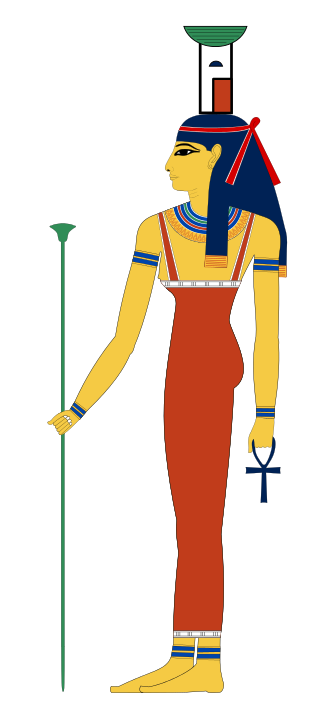
- Animal Motif: She's one of the few Egyptian deities to not have a heavy association with a particular animal, but she does get linked to kites on occasion, as the Egyptians compared their cries to the wails of a mourning woman.
- Awful Wedded Life: Her marriage to Set was occasionally depicted as unhappy or abusive to further demonize Set and/or justify her Bed Trick with Osiris.
- Bed Trick: Disguised herself as Isis once and slept with Osiris, which was how Anubis was conceived in some later tellings.
- Breath Weapon: According to certain sources, she was capable of breathing fire to incinerate the enemies of the pharaoh.
- Brother–Sister Incest: With Set, her husband. In some versions she also had this with Osiris, who she Bed Tricked.
- Continuity Snarl: Scholars suspect that this might explain her contrasting characterizations: Set's cult (with emphasized him as the protector against Apophis) made her his wife, Osiris' cult (which emphasized Set as a murderer) made her his and Isis' ally, and later interpreters were left to make sense of the story.
- Darker and Edgier: When associated with the afterlife.
- Dark Is Not Evil: Despite being associated with death, her role was rather to protect and guide the souls of the dead. Bed Trick of Osiris in some myths aside, she was Isis's loyal ally in protecting Horus and was never portrayed as actively villainous like her husband Set.
- Out of Focus: Nephthys never really received much individual attention in the myths compared to her siblings. She usually only appeared in relation to Isis, Set, or Osiris, and there are few stories where she is the main focus.
- Undying Loyalty: Unlike Set, she was staunchly loyal to Osiris and Isis and helped the latter protect and raise Horus in hiding.
- Water Is Womanly: The goddess of rivers and childbirth. In the Horus legend, she provided refuge to Isis after Set dismembered her husband, Osiris, and threatened to kill their child, whom Nephthys raised. The child, Horus, ended up overthrowing Set and becoming the new pharaoh. As a result, she also came to symbolize divine guardianship.
𓇋𓈖𓊪𓅱𓃣 | Ἄνουβις | Anubis/Anpu/Inpu note

Anubis, the jackal god of mummification, judge of souls, Guardian of the Scales, and lesser god of the afterlife, is the most recognizable of all Egyptian gods. His parentage is disputed depending on the source; he is sometimes considered the son of Osiris and Nephthys through an affair, but more commonly considered the son of Set and Nephthys. However, unlike Set, Anubis had great compassion for humanity, and their differences went so far as to lead to Set abandoning him. He later became one of Horus's chief allies against Set. He weighs every dead person's heart against the feather of Ma'at (Justice); if it's too heavy from wicked deeds, the heart gets eaten by a nearby monster, Ammit the Devourer of the Dead. Otherwise, the righteous dead person may proceed to the Afterlife.
- Adaptational Villainy: While by no means evil in Egyptian Mythology, he's often portrayed as an evil death god in pop-culture.
- Animal Motif: He is prominently associated with jackals due to their tendency to hang around graveyards.note
- Ascended Extra: Often depicted as the primary Egyptian God of Death in popular media, while the truth is more complicated. There's evidence in the early dynasties of the Old Kingdom that Anubis was originally the preeminent God of Death and the Dead, but Osiris quickly surpassed him. One narrative interpretation is that Anubis stepped down from the position when Osiris entered the afterlife; another is that they actually serve different roles, and while both are gods of the afterlife, Osiris is the God of the Dead (those who dwell in the afterlife), while Anubis is the actual God of Death (the transition process between life and afterlife), which fits with one being strongly associated with kingship even in death and the other with the actual funeral rites, process of mummification, and the many post-life trials described in The Book of the Dead. The latter is further supported by the fact that, rather than having been considered the overseer of the transition between life and death as Anubis is, Osiris was (symbolically) the deceased individual undergoing funeral rites (according to surviving texts, the deceased is even ritualistically referred to as "Osiris" during said rites). It's likely this developed from some areas of Egypt worshiping Anubis as God of Death and others worshiping Osiris, and when the kingdom united a narrative was created that allowed both to coexist.
- Breakout Character: Despite his relatively humble role in the grand scheme of Egyptian mythology, Anubis is the Egyptian god in modern pop culture. He is likely the most widely recognized Egyptian god, and whenever the ancient Egyptian pantheon needs to be represented, Anubis will always be among the roster- in some cases, even the chief god. It's not uncommon for a Fantasy Counterpart Culture to even have a race of Anubis expies. The modern exaggeration of Anubis' importance is possibly due to the spike in Egyptomania in the nineteenth and twentieth century when archeologists and collectors became obsessed with Egyptian tombs and mummies, Anubis' own domain.
- Child by Rape: He's this in the myth where Nephthys pulls a Bed Trick on Osiris and sleeps with him in the guise of Isis, conceiving Anubis.
- Dark Is Not Evil: Despite being a god of the dead and depicted as a black jackal, he's a just god and a pretty cool guy.
- Depending on the Writer: Who his father is depends on the myth and time period. Earlier myths placed him as Set's trueborn son, but the demonization of Set after the Hyksos invasions made the myth where he was sterile and thus Anubis was actually Osiris's become more common.
- The Dog Bites Back: Somewhat literally. Set was not kind to Anubis and in many versions of his myth abandoned or disowned him. After Set murdered Osiris and took the throne, Anubis became one of the most ardent supporters of the ousted former royals and helped Isis partially resurrect Osiris in order to conceive an heir, Horus, who would eventually oust Set in turn. There was also the myth about him fighting Set when the latter tried to mutilate Osiris's re-assembled corpse, which ended with him branding Set's leopard form with a hot iron (the "Just So" Story for the leopard's spots), flaying him, and wearing his skin afterwards.
- Everybody Hates Hades: Often depicted as a villain in pop-culture when he was far from it.
- Female Feline, Male Mutt: He was sometimes depicted as a duo with Mafdet by way of her symbol in art on royal tombs being associated with his, with Anubis being the gods' chief attendant and Mafdet being the gods' chief executioner.
- Heroic Dog: Positive portrayals of Anubis tend to paint him like this.
- Judgement of the Dead: He played an important role in the process of death, overseeing the judging of each soul and determining if they were worthy of passing on.
- Mama's Baby, Papa's Maybe: He's consistently the son of Nephthys, but whether his father is Set or Osiris varies in the myths.
- Parental Abandonment: The myths where he is Osiris's son have Set or Nephthys, or both, abandon him and leave him to be taken in by Isis. Even in the versions where he is Set's son, though, Set is usually a lousy parent.
- Psychopomp: One of several gods thought to play this role.
- The Reliable One: He was relatively insignificant in Egyptian mythology, standing on the sidelines just doing his job. However, the fact that his image is (obviously) plastered all over tombs led him to becoming one of the most iconic Egyptian deities in modern culture.
- Scales of Justice: Anubis was the "Guardian of the Scales" and primary wielder of the Scales of Ma'at. After death, the deceased would journey to Anubis' Hall of Truths, and there Anubis would begin the Weighing of the Heart ceremony by weighing the deceased's heart against the Feather of Ma'at. The deceased would then make a series of negative confessions before Anubis (with Osiris sometimes presiding), denying that they committed various malicious and disorderly crimes in their life. If they lied, the scales would lose balance and the heart would fail the trial. It would then be fed to Ammit.
- Screw Yourself: In a sense. Anubis' consort, unlike other Egyptian gods, was his female counterpart, Anput. The two even have a daughter, Kechebet, together.
𓎰𓏏𓏏 | Αἴλουρος | Bastet/Bast/Baast/B'sst/Ubasti/Ubaste note
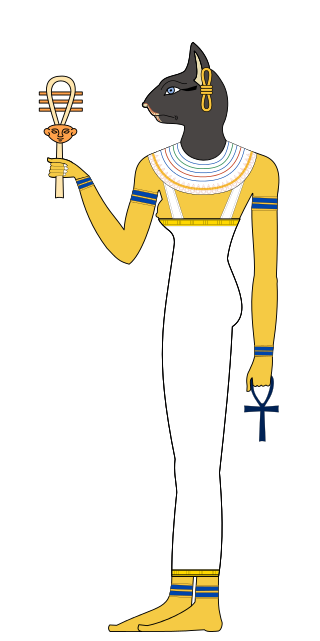
- Animal Motifs: She appears as a small cat or a lioness.
- Beware the Nice Ones: Was originally a savage lion goddess akin to Sekhmet.
- Breakout Character: Along with Anubis, Bastet is probably the most commonly known and popular Egyptian god to casual observers despite her comparatively smaller role in the myths themselves.
- Cat Folk: Possibly the Ur-Example, Bast is a humanoid with a cat head.
- Fiery Lion: Started off as a sun goddess similar to Sekhmet, with leonine features, though she became increasingly associated with domestic cats in later periods.
- Friend to All Children: As a deity who protected the household, she was also associated with the welfare of the common folk's children.
- Half-Human Hybrid: Often depicted with the head of a cat and as the goddess of cats.
- Kid-Appeal Character: She was associated with children due to her role as a household protector, making her perhaps an Older Than Dirt example of this.
- The Lancer: After Set's demonization, Bastet takes his role as Ra's primary champion against Apep.
- The Power of the Sun: Sometimes worshipped as a sun goddess.
𓅃 | Horus/Her/Heru/Haru/Hor/Har note
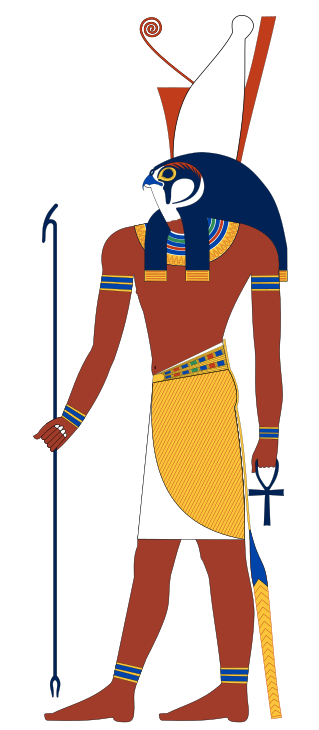
- Animal Motifs: The falcon, as he was a sky god. 𓅃
- Blow You Away: The god of the sky.
- Composite Character: He was occasionally combined with Ra (forming Ra-Horakhty) or Sobek (forming Sobek-Horus). On a slightly more confusing note, he was at one point two different characters known as Horus the Elder and Horus the Younger. Horus the Elder was Heru-ur, the son of Geb and Nut, brother to Osiris, Isis, Set, and Nephthys, and lord of the sky; Horus the Younger was Heru-sa-Aset (literally "Horus, son of Isis"), the son of Osiris and Isis who challenged Set for the throne. From the New Kingdom onwards, Horus the Elder gradually fell by the wayside and was fused with Horus the Younger, and Heru-ur became just another epithet for the latter. (The only exception to this was the Greeks, who identified Horus the Elder, not the Younger, with Apollo.)
- Depending on the Writer: He is perhaps the biggest example of this in Egyptian myth, rivaled only by Hathor. Myths varied and contradicted each other over the ages as to whether he was the fifth child of Geb and Nut and thus the brother to Set, Isis, Osiris, and Nephthys, or an aspect of Ra, or a son of Ra, or the son of Osiris and Isis. Later versions seemed to settle on him being the last one (and virtually all adaptations in popular culture have followed suit), but he was still often associated with Ra (they were at times depicted as one deity named Ra-Horakhty, literally "Ra, who is Horus of the Two Horizons").
- Eye Motifs: The image of his left eye was used as a widespread symbol of healing and protection, called the Eye of Horus. 𓂀
- Eye Scream: Had one of his eyes gouged out by Set. Thoth replaced it with a silver one, representing the moon.
- Gender Bender: Horit
 is his female form.
is his female form. - God-Emperor: The Pharaohs were held to be his earthly incarnation.
- The Good King: Like his father, he was worshiped as a benevolent king and the model for the pharaohs to strive to be like.
- Half-Human Hybrid: Had the head of a falcon.
- The Hero: He is portrayed as this in the Osiris myth, being the son of the murdered Osiris who seeks to avenge his death and take back the throne from his Evil Uncle Set.
- Hijacked by Jesus: Often shoehorned into the Jesus role, especially by people who watched Zeitgeist. Let's make a couple of things clear: Horus was not born on December 25th (...maybe, though his birthdate was not relevant in cults), and was most assuredly not born of a virgin. He did resemble Jesus in that he was a deity associated with healing and with resurrection - though he only "resurrected" if you go by Greek notions that he was his father, Osiris, reborn.
- Lunacy: Although he was associated with the Sun, he was also associated with the Moon, and it was thought that both were his eyes, the moon being the less bright eye because he was blinded by Set in their battles.
- Noble Bird of Prey: His animal form was a falcon, and he was depicted in the myths as a heroic protector and king who fought evil and avenged his father's murder by defeating Set.
- The Power of the Sun: Another sun god.
- Royal Brat: The "Contendings of Horus and Seth" play, a satire that ridiculed the council of gods that dawdled on whether Set or Horus should be king, portrayed him as an immature child who cries when beaten.
- Top God: Horus took his place as king of the gods instead of Ra after Isis' coup. Interestingly, Ra seems to have still held the position in an emeritus sort of way, and retained chief responsibility for fighting Apep.
- You Killed My Father: He feuds with Set over the throne to avenge his father, Osiris, after his murder at Set's hands. Rather unusually for the trope, early versions of the Osiris myth actually had Horus forgive Set for killing his father after Set repented for it, and they divided Egypt equally between them (symbolizing the union between Upper and Lower Egypt). As Set was increasingly demonized as a God of Evil after invasions from the Hyksos, this changed and Horus took the traditional route of banishing or killing Set in retribution instead.
𓌂𓐍𓏏𓁐 | Sekhmet/Sakhmet/Sachmis note

- Animal Motif: She's always portrayed as a lioness.
- Animorphism: The story of her rampage typically has her showing up as a straight-up lioness (with giant fangs and claws), not as a lioness-headed woman.
- Ax-Crazy: Was initially unleashed upon humanity as a punishment, but the more people she slaughtered only increased her bloodlust, until she threatened to wipe out humanity entirely.
- Blood Knight: Her rampage ended only when Ra got her drunk on beer made to look like blood.
- Breath Weapon: Sekhmet's burning breath is compared to the hot desert winds.
- Fiery Lion: A sun goddess typically depicted with a lion head.
- God of Light: A sun goddess, specifically representing the harsher aspects of the sun.
- Gone Horribly Right: The gods unleashed Sekhmet as a standard punishment to humanity, but they immediately started a backup plan when she was getting increasingly high on her own carnage and trying to wipe them out completely.
- Half-Human Hybrid: Often depicted with the head of a lioness.
- Heel–Face Turn: After being tricked into drinking a lake of alcohol, she becomes much more chill, and in some versions of the myth, this causes her to become Hathor, goddess of love and (appropriately enough) drinking and partying. Other myths have her become the mother goddess Bastet when she is soothed.
- I'm a Humanitarian: Hence her being finally placated by beer made to look like blood.
- Interplay of Sex and Violence: Depending on her form she is either a bloodthirsty destroyer or a Hard-Drinking Party Girl.
- Intoxication Ensues: How Sekhmet was defeated: knowing that she drinks the blood of humans, Ra filled a lake with either red wine, or beer that was dyed red, so she'd be too drunk to continue her rampage.
- Jekyll & Hyde: A savage war goddess whose alternate form is the benevolent goddess Hathor (or alternatively, the mother goddess Bastet). Some versions of the myth about her rampage reverse the usual set-up so that she starts off violent, and only gains the tame personality of Hathor after being pacified with beer she mistook for blood.
- Light Is Not Good: She was also associated with the sun.
- Monster Is a Mommy: Some sources have her being the mother of Nefertem, god of beauty and grace. She's also seen as the mother of Maahes, another lion-headed war god.
- Names to Run Away from Really Fast: Held titles such as the "Lady of Slaughter" and the "Mistress of Dread".
- Omnicidal Maniac: She was originally unleashed just to take out those who betrayed Ra, but soon went out of control and tried to slaughter all of humanity.
- Plaguemaster: She is a war goddess, but the Egyptians were well aware that disease inevitably follows armies.
- The Power of the Sun: As a solar deity, she is depicted wearing the solar disk and uraeus.
- Sinister Sentient Sun: She represents the negative aspects of the sun, such as its harsh light and brutal heat, and her most famous story is about how she got carried away with her ordered rampage and tried to commit genocide.
- Thirsty Desert: As the embodied wrath of Ra she embodies the destructive, negative aspects of the Sun.
- War God: The Egyptians had a number of war deities, but Sekhmet seems to embody bloodthirst and slaughter more than anything else.
𓅝𓏏𓏭𓀭/𓆓𓎛𓅱𓏏𓏭𓊹 | Θώθ | Thoth/Djehuty note
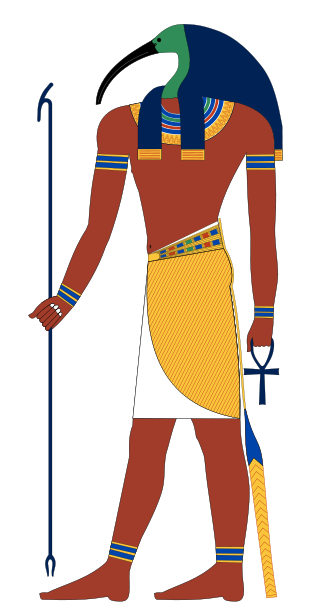
Thoth is the god of the moon, wisdom, medicine, astronomy, magic, and writing. He can appear as an ibis, ibis-headed man, or baboon. In one myth he was the one responsible for tricking Sekhmet into drinking blood-colored wine and ending her rampage. In some stories, he is married to Ma'at, the goddess of balance; other stories hold that he is married to the lesser-known goddess Nehmetawy (who in turn is sometimes married to Nehebkau in other stories) or to Seshat, the goddess of writing (when she wasn't depicted as his daughter).
- The Archmage: He was usually the most powerful spell user in the pantheon, and was rivaled only by Isis.
- Animal Motif: He is usually portrayed with the head of an ibis, and is also associated with baboons.
- Badass Bookworm: Wise, and no less aggressive. There's a reason why the baboon is his symbol, after all.
- Bookworm: Thought to have invented writing and most if not all areas of knowledge.
- Depending on the Writer: His consort was hardly consistent and varied between Ma'at, Nehmetaway, or Seshat. Seshat was sometimes said to be his daughter with Ma'at instead.
- Exact Words: Ra forbade Nut from giving birth on any day of the year, which was then 360 days. Thoth used this to his advantage by creating five more days.
- God of Knowledge: He was considered to be the patron of most intellectual pursuits, such as writing, astronomy, medicine, and magic.
- Good with Numbers: Part of his job as when the universe was created was to calculate the optimal placement for everything.
- He Knows Too Much: Apparently kills humans who know too much.
- Immortal Genius: Credited with the creation of writing and the author of all works of science, religion, and magic.
- Intelligent Primate: Thoth is the god of wisdom and sometimes associated with the Hamadryas baboon.
- Lunacy: A moon god. In the Heliopolis Creation Myth, he also gambled with the moon to add five extra days to the calendar, hence 365 days, to allow Nut to give birth to her children since Ra had forbidden her to give birth on any day of the year. (Some traditions give this role to Khonsu instead.)
- Maniac Monkeys: Less famous than his association with the ibis is that with the baboon, an animal perceived as dangerous and unpredictable to Ancient Egyptians. For even the wise Thoth kills "those who know too much" and is invoked in his most fearsome monkey visage in funerary contexts.
- Reasonable Authority Figure: When he saw that Nut despaired over not being able to birth her children, Thoth stepped in and helped her.
- The Smart Guy: Well renowned for his intelligence.
𓌴𓐙𓂝𓏏𓏛 | Ma'at/Maat/Ma'et note

- Abstract Apotheosis: Sometimes depicted as an actual deity to be appeased, sometimes just considered an abstract concept that was beyond mortal comprehension.
- Balance Between Order and Chaos: An unusual example, since she is both the goddess of order and the goddess of balance - and, for that matter, the goddess of justice. One possible reading is that the existence of each of these things depends on the others - in short, that there is no order without balance or justice. In particular, Ma'at called upon the fortunate to clothe the poor and feed the hungry; the Egyptians also held that Ma'at was the spirit in which justice was applied rather than the letter of the law and that Ma'at bound all things together in unity.
- Cosmic Keystone: The whole of the Egyptian state religion was dedicated to the protection and preservation of Ma'at, otherwise Apep would devour the universe.
- Distaff Counterpart: To Thoth.
- God of Order: While most gods were considered forces of order, Ma'at is the literal embodiment of order, as she represents balance.
- Order Versus Chaos: Balanced against Apophis.
- Scales of Justice: Ma'at is sometimes depicted in human form helping Anubis and/or Osiris in the Weighing of the Heart Ceremony. This makes sense since the heart is weighed against Ma'at, though it is usually depicted as a feather when on the Scales.
- Winged Humanoid: Is often depicted with feathered wings under her human arms [2]
 ◊.
◊.
𓋴𓃀𓎡𓆊/𓆋 | Σοῦχος | Suchus | Sobek/Sochet/Sobki note

- Ambiguously Evil: As with his father, the religion flip-flops whether he's evil or not. Then again, seeing as he represents the duality of the river Nile (both the life giving waters, as well as the destructive floods), it's possible he operates on a different morality.
- Animal Motif: Since he's the god of the Nile, he's associated with crocodiles.
- Ascended Extra: He was a minor god in the Old Kingdom, but attained prominence in later dynasties (especially in the New Kingdom) when he was combined with Horus and Ra and also became a solar god.
- Composite Character: From the Middle Kingdom onwards, he was often fused with Horus and Ra to be Sobek-Horus and Sobek-Ra, respectively.
- A Hero to His Hometown: Depending on where you were, you were liable to hear people describing him as a dangerous monster who was to be feared and avoided. However, were you in the Faiyum (where the seat of his cult was), saying this would likely get you accused of blasphemy and fed to the sacred crocodiles there.
- Interspecies Romance: Ironically, he was said to be lovers with the hippo goddess Tawaret. In real life, crocodiles and hippos are antagonistic animals that regularly fight over territory.
- Jerk with a Heart of Gold: He was an aggressive, animalistic god with unfriendly-sounding epithets like "he who loves robbery" and "pointed of teeth", but he was also worshiped as a benevolent protector who defended the innocent from evil. Some versions of the Osiris myth have him help Isis resurrect Osiris by finding some parts of his body.
- Making a Splash: Due to being the god of the largest river in the world, he qualifies for this trope.
- Meaningful Name: A twofold example. His name is often thought to be based on the ancient Egyptian verb "to impregnate", in keeping with his Really Gets Around reputation. Some scholars have suggested that his name is instead derived from an alternate spelling for the ancient Egyptian verb "to unite", meaning that his name roughly translates to "he who unites [the dismembered body parts of Osiris]".
- Never Smile at a Crocodile: Sometimes revered, sometimes reviled, he was rather ambiguous in terms of worship. He brought fertility, but his sacred animal is extremely dangerous, and he was said to take women from their husbands whenever he felt like it.
- Odd Name Out: In a way. Most of the major Egyptian gods are popularly known in the public eye by the Greek renditions of their names (Osiris, Horus, Isis, Anubis, Thoth, etc.). Sobek is the only one to be known more by his Egyptian name than his Greek one, Suchus.
- Really Gets Around: Sexuality was a strong motif with him as a Fertility God. His epithets include "he who steals wives from their husbands" and "Lord of semen".
- Reptiles Are Abhorrent: Zigzagged. On one hand, he was uniformly portrayed as a vicious and bestial deity who often stole women and took sadistic pleasure in battle (in keeping with the perception of crocodiles as violent predators). On the other hand, he had several prominent cults who deified him as a benevolent guardian against evil, and the Osiris myth depicted him as helpful in resurrecting Osiris.
- Serial Homewrecker: One of his titles literally translated to "lord of semen, who takes wives from their husbands".
𓎛𓈎𓏏𓆏𓋾𓈎𓏏𓁐𓎟 | Heqet/Heket/Heqtit note

- Alternate Company Equivalent: To Hecate, as mentioned above. Though Heqet predates her and possibly inspired her, notice that their names are almost identically written.
- Frog Men: Played with, in that she was usually portrayed as a regular human divine being instead [3]
 ◊. Worth knowing is that she is a "younger" deity than Kek, who is a primordial entity and thus he's the true Ur-Example.
◊. Worth knowing is that she is a "younger" deity than Kek, who is a primordial entity and thus he's the true Ur-Example. - Healer God: She was also a goddess of health and healing, and was worshiped by medical practitioners.
𓏠𓈖𓍿𓅱 | Montu/Mont/Monthu/Montju/Ment/Menthu note

- Animal Motifs: He was depicted as either a falcon or a bull, with the falcon representing his association with the sky and the bull representing his strength in war.
- Brutish Bulls: Because bulls embodied raging strength and warfare, he was often portrayed with a bull's head. Sometimes he was said to manifest in the form of a sacred bull called Buchis.
- Composite Character: With either Ra or Horus, other gods who symbolized kingship, to respectively form Montu-Ra or Montu-Horus.
- Demoted to Extra: His center of worship was Thebes, which he was originally the chief patron god of before Amun overtook him in popularity. His prominence was at its highest in the Middle Kingdom, where several pharaohs (Mentuhotep I, Nebhepetre Mentuhotep II, Sankhkare Mentuhotep III, and Nebtawyre Mentuhotep IV) took names after him, but his profile was mostly diminished afterwards in favor of Ra and Horus.
- God of Light: As an aspect of the sun god Ra, he was also a solar deity.
- Noble Bird of Prey: He was a falcon god who, despite not doing much in the myths, was important as a representative of the pharaoh's warrior image.
- War God: He was a war deity that symbolized the conqueror aspect of Egyptian kings, who were expected to lead their armies in battle.
𓊪𓐍𓏏𓃭 | Pakhet/Pachet/Pehkhet/Phastet/Pasht note

- Animal Motifs: She was usually portrayed as a lioness or caracal.
- God of Light: As a solar deity, she was also associated with Hathor and was illustrated with a sun disc headdress.
- War God: She was another lioness goddess of war, though she was depicted more often as a hunter (one who stalked prey at night) than as a warrior (one who actively fought enemies of Egypt).
𓊃𓎡𓂋𓊞 | Seker/Sokar/Socharis note

- Animal Motifs: Mummified falcons, referring to both his status as god of the dead and his association with Ra.
- Composite Character: As a god of both craftsmanship and the afterlife, he was frequently combined with Ptah and Osiris. All three of them would also be merged to form the deity Ptah-Seker-Osiris, enforcing the balance between creation and death.
- Dark Is Not Evil: He embodied the afterlife and was affiliated with darkness and tombs, but was also a benevolent guardian and guide of the dead.
- Meaningful Name: His name had a few different possible meanings. It could be derived from skr, "cleaning the mouth", in reference to how bodies had to be cleaned out completely from the inside in preparation to be mummified, or Sy-k-ri ("Hurry to me"), Osiris's cry to Isis after his death as described in the Pyramid Texts.
𓌴𓁹𓆑𓂧𓏏𓌞𓅆 | Mafdet/Mefdet/Maftet note

- Animal Jingoism: She was a protector against all venomous creatures, and was sometimes portrayed with a mongoose's head to signify the real life enmity between mongooses and snakes.
- Attack on the Heart: Her main method of executing evildoers was to rip their hearts out so she could drop them at the feet of the Pharaoh.
- Demoted to Extra: She was a prominent deity in the Old Kingdom, where she was depicted as Ra's main protector, but her relevance faded over time as Ra became associated with other defenders (Set, Bastet) and as Bastet's status as the chief feline goddess encroached on hers.
- Female Feline, Male Mutt: She was sometimes depicted as a duo with Anubis by way of her symbol in art on royal tombs being associated with his, with Mafdet being the gods' chief executioner and Anubis being the gods' chief attendant.
- Furry Reminder: When portrayed in her animal form, she was often given the feline characteristic of presenting Ra with the hearts of evildoers she had torn out like how a cat presents its owner with dead birds or mice.
- War God: Due to representing capital punishment, she was often called on as a protector goddess in times of war and had titles like "Piercer of Darkness".
𓆣𓂋𓇋𓁛 | Khepri/Khepera/Kheper/Khepra/Chepri note
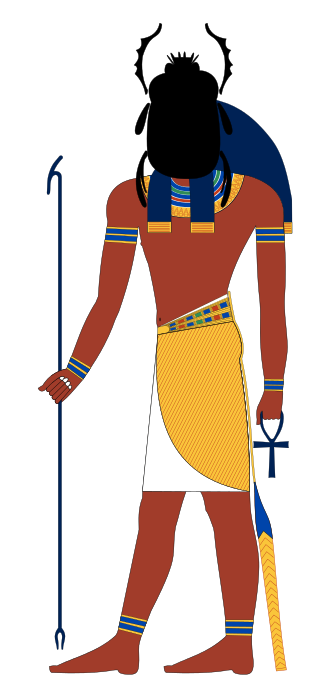
- Animal Motif: Dung beetles, with which Ra was also associated. The beetle pushing a ball of dung behind itself reminded the Egyptians of the way the sun moved across the sky.
- God of Light: Another solar god like Ra.
- Light Is Good: Like Ra, Khepri is a benevolent deity, symbolizing the life giving solar light.
- Non-Standard Character Design: While the other deities are depicted as regular humans or people with animal heads and traits, this god has an entire animal as a head.
- Scarab Power: The Trope Maker and Ur-Example. When the ancient Egyptians saw dung beetles rolling balls of poop, they thought that up there in the Cosmos there is a divine scarab that does the same with the Sun.
𓊃𓂋𓈎𓏏𓁐 | Serket/Serqet/Selket/Selqet/Selcis note

- Animal Motif: Like Isis, she is associated with scorpions.
- Dark Is Not Evil: Despite her scorpion motif, she was a protector against evil and healer of all poisons. Like all deities, though, it was also a good idea to avoid getting on her bad side.
- Demoted to Extra: She was one of the oldest deities in Egyptian mythology and was very popular in the early days of the Old Kingdom, but over time she lost prominence. Her associations with protection, magic, and healing led to her being slowly gobbled up as Isis became more popular. Towards the end of the ancient Egyptian religion's lifespan, the few areas that still remembered Serket worshipped her as a local aspect of Isis.
- Lady of Black Magic: Was associated with ritual magic at various points.
- Scary Scorpions: Subverted, she is a benevolent scorpion goddess. It's her duty to protect people from venomous stings and bites, as well as heal any wounds and poisons.
- Sigil Spam: Symbols relating to her were very common in the Pre dynastic period, although its not really known if she predated the scorpion motif or if she was created to give a face to an already popular symbol.
- Time Abyss: Goddesses with scorpion motifs have been found from archeological sites that pre-date the Old Kingdom, making her more ancient than Egypt itself, and she probably goes back even further than that.
𓏎𓈖𓁷𓂋𓏏𓈐𓅆/𓏎𓈐𓇯𓅆 | Anhur/Onuris/Onouris/An-Her/Anhuret/Han-Her/Inhert note
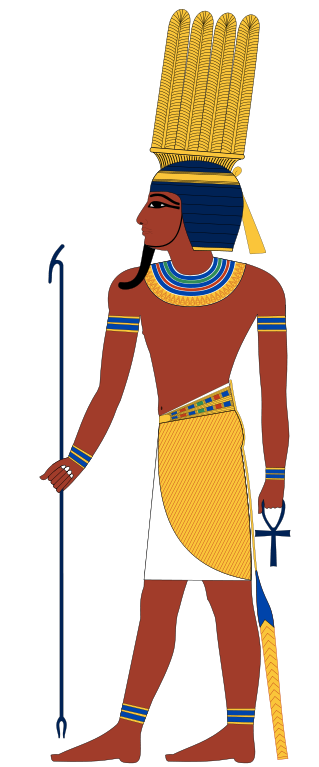
- Animal Motif: His sacred animal is the male African lion.
- Meaningful Name: His name translates to "one who leads back the distant one", referencing that he brought his female equivalent, Mehit, from Nubia to be his wife.
- War God: He was the patron of the Egyptian army and the representative of its warriors. Because of this, the Greeks identified him with Ares.
𓏏𓄿𓅨𓂋𓏏𓆗 | Θουέρις | Tawaret/Reret note
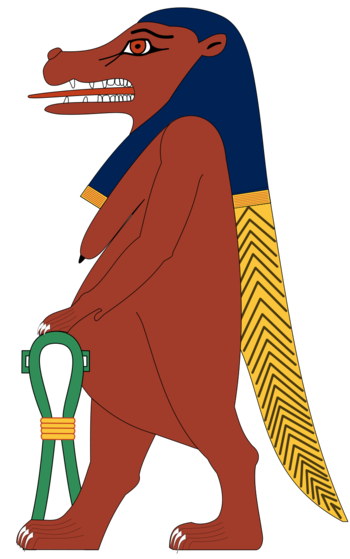
- Animal Motif: Hippos.
- Ascended Extra: Double-subversion; she is not among the chief deities, but she was a well-known household goddess.
- Dark Is Not Evil: Although married to the above-mentioned Set, she is generally a benevolent goddess. She protects women (pregnant women in particular), and she restrains her husband from doing evil.
- Expansion Pack Past: Started off as evil, then regarded as benevolent. She may also be another aspect of the above-mentioned Hathor.
- Expy: Has one in the form of the soul-eating demoness Ammit. Where Tawaret gives life, Ammit takes it away.
- Good Is Not Nice: Sometimes has to lasso her husband to keep him in line and protect humanity.
- Huggy, Huggy Hippos: A protector of pregnant women and babies depicted with the head of a hippopotamus.
- I Have Many Names: Tawaret, Tuaret, Tuart, Reret, Thouéris, just to name a few.
- Interspecies Romance: A very ironic one; she's a hippo, and her lover Sobek is a crocodile. In Real Life, these particular animals do not get along.
- Kavorka Woman: Takes the form of a hippo with pendulous breasts, but she has multiple lovers and is pretty much always pregnant, so she must be doing something right!
- Longest Pregnancy Ever: Seems to always be pregnant.
- Mama Bear: Protector of pregnant women and babies.
- Mix-and-Match Critter: Has characteristics of a hippo, a lion, and a human, and sometimes a crocodile.
- Non-Standard Character Design: Egyptian gods tend either to be fully humanoid, or have the body of a human and the head of an animal. Tawaret has the distinction of being almost entirely beastly. In some representations, she has the chimeric characteristics of multiple animals, chiefly hippos, and at other times she is simply an upright hippopotamus, but she is never seen as a normal human woman with a hippo head.
- Pregnant Badass: Protects women and children, keeps her evil husband in line, and is perpetually pregnant.
- Really Gets Around: Is married to Set, and has Bes and Sobek (and several other gods) as lovers. Sobek seems to be her favorite, though.
- Sympathetic Adulterer: No one seems to have a problem with her cheating on her husband, probably because he is the Big Bad.
𓎸𓃝 | Χνοῦβις | Khnum note

- Animal Motif: He has a goat's head.
- Fauns and Satyrs: Played with, he is a human deity but with a ram's head.
- The Power of Creation: He created both humans and the other deities with only a potter's wheel and clay.
𓂋𓈖𓈖𓅱𓏏𓏏𓆗 | Renenūtet/Ernūtet/Renenet note
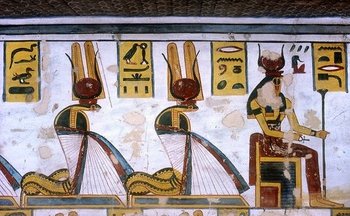
- Animal Motif: Cobras.
- Snake People: Was depicted either as a cobra, or as a woman with the head of a cobra.
- Snakes Are Sinister: Averted, she isn't evil at all.
𓋇𓏏𓁐/𓋈𓏏𓁐 | Seshat/Safkhet/Sesat/Seshet/Sesheta/Seshata note
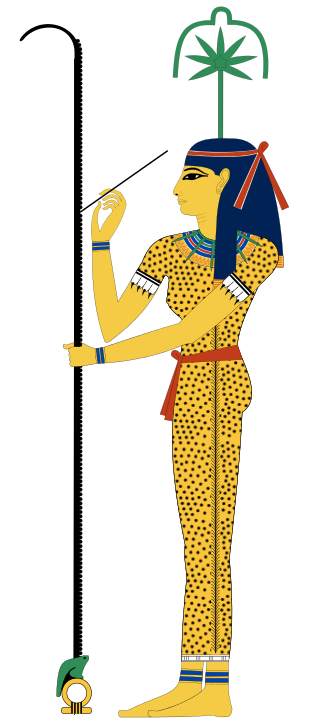
- Animal Motif: Cheetahs.
- Depending on the Writer: The myths varied as to whether she was the wife of Thoth or the daughter of Thoth and Ma'at.
- Parent-Child Team: She is sometimes depicted as the daughter of Thoth and takes care of the bureaucracy on earth while he is busy keeping the universe running smoothly.
- Renaissance Man: The description above is a good indicator that she had power over plenty of domains. Granted, she is a goddess.
- Women Are Wiser: Also is a goddess of wisdom, among other things.
𓐍𓈖𓇓𓅱 | Khonsu/Chonsu/Khensu/Khons/Chons/Khonshu note
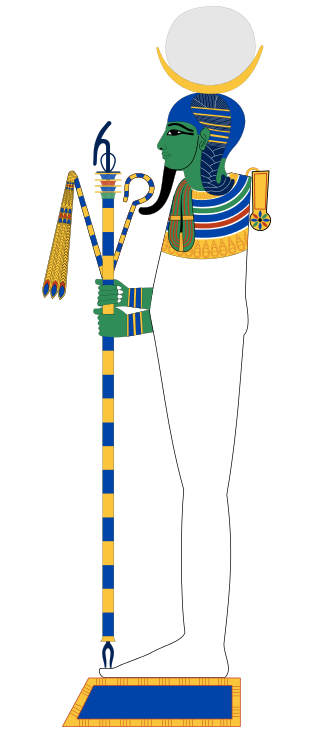
- Bird People: Is sometimes depicted as having the head of a bird, a falcon to be exact.
- The Gambler: A Depending on the Writer/"Rashomon"-Style example. In some versions of the myth, he's the one responsible for giving Nut an extra five days of the year by gambling hours of moonlight and repeatedly losing to her.
- Lunacy: He's yet another moon god like Thoth.
- The Maker: Another Depending on the Writer/"Rashomon"-Style example. In a creation myth from the late Ptolemaic Period, the world results from his coupling with Hathor; another myth holds that he is the great snake who fertilises the Cosmic Egg and thereby creates the world. Khonsu is not involved in some other creation myths, in which the world instead results from an act of masturbation by Atum (usually with his hand personified by a female goddess such as Hathor, Nebethetepet, or Iusaaset). Various myths also hold that Khonsu is involved in some fashion in the creation of all living creatures, and that when he makes the crescent moon shine, women conceive, cattle become fertile, and all mouths, nostrils, and lungs are filled with fresh air.
- Snakes Are Sinister: Averted; he takes on the guise of a snake in some stories, but he is involved in creating life itself and is also a god of healing.
- Time Master: His primary domain is the passage of time.
𓅐𓏏𓆇𓁐 | Mut/Maut/Mout note

- Animal Motifs: Lionesses were affiliated with her, making her the Upper Egyptian counterpart to the Lower Egyptian lion goddess Sekhmet. She was also portrayed with the wings of a vulture.
- Cool Crown: She was frequently depicted with the pharaoh's red-and-white double crown (symbolizing the union of Upper and Lower Egypt) and the queen's vulture headdress, wearing both at the same time.
- The High Queen: She was a benevolent mother goddess who represented queenship, and enforced the Egyptian queen's role as a maternal figure to the people.
- Meaningful Name: Her name was the ancient Egyptian word for "mother".
𓈙𓊃𓅓𓅱𓀭 | Shezmu/Shesmu/Schesmu note

- Agent Peacock: He was the god of fragrant perfumes and beautifying oils, as well as a ruthless executioner with a taste for gore.
- Animal Motifs: His animal symbols were falcons and lions.
- Beware the Silly Ones: He was associated with festivities and joyous celebrations, as well as singing and dancing, in addition to being a bloodthirsty maniac who used his wine press to crush in heads. His titles were things like "Lord of the Blood", "Slaughterer of Souls", and "Overthrower of the Evil at the Block".
- Blood Knight: Rivaled Sekhmet in his bloodthirstiness and love of slaughtering evildoers, except he used a press to do it. Fittingly, Sekhmet was sometimes said to be his mother.
- I'm a Humanitarian: Some Old Kingdom texts had prayers for him to butcher and cook the other gods to serve them to the king for him to consume and absorb power from.
- Off with His Head!: What he did to his victims. He tore off their heads and threw them into the wine press to crush them, just like grapes.
𓈖𓐍𓃀𓇑𓏏𓅐 | Nekhbet/Nekhebit note

- Animal Motif: Vultures.
- Cool Crown: Was paired with her counterpart Wadjet on some pharaohs' crowns. She was also symbolized by the vulture headdress that queens and female pharaohs wore, which she was depicted with when portrayed as human. This was due to vultures being associated with motherhood (the hieroglyph for vulture, mwt, was also used in the word for "mother").
- The Dividual: Was often invoked alongside the snake goddess Wadjet, protector of Lower Egypt; they were known together as the "Two Ladies" as joint protectors of the united realm. The Nebty or "Two Ladies" name of the king (part of the five-part royal titulary) specifically invoked them together and usually referenced the monarch's protection of both Upper and Lower Egypt. However, neither one actually did much in any myths; they were more important as symbols of Egypt than as characters.
- Vile Vulture: Averted, she was a benevolent deity and protector who was associated with motherhood and queenship.
𓇅𓇌𓏏𓆗 | Οὐτώ/Βουτώ | Wadjet/Wedjat/Uadjet/Udjo note

- Cool Crown: Is depicted as one, and also serves as a decoration alongside her vulture counterpart Nekhbet for the pharaoh's crown, which itself also qualifies for this trope
 . Her symbol was called the Uraeus.
. Her symbol was called the Uraeus. - Delightful Dragon: She is a winged serpent that breathes fire... and she is also the guardian of the pharaoh and the sun god Ra.
- The Dividual: Was often invoked alongside the vulture goddess Nekhbet, protector of Upper Egypt; they were known together as the "Two Ladies" as joint protectors of the united realm. The Nebty or "Two Ladies" name of the king (part of the five-part royal titulary) specifically invoked them together and usually referenced the monarch's protection of both Upper and Lower Egypt. However, neither one actually did much in any myths; they were more important as symbols of Egypt than as characters.
- Dragons Are Divine: Wadjet is a divine serpent Goddess who protects the pharaoh and Ra.
- Feathered Serpent: A good example that is as old, or even older than the two more famous Trope Makers - the Pre-Columbian Mesoamerican deities Kukulkan and Quetzalcoatl.
- Mix-and-Match Critters: Has been depicted as a winged snake, a snake woman, a bird woman, or any combination of the previous depictions.
- Snakes Are Sinister: Averted; while serpentine, she is a benevolent protector goddess.
Minor Deities
𓎛𓐑𓊪𓃒/𓅭/𓐑𓊪𓅱/𓐑𓊪 | Apis/Hapis/Hapi-ankh note
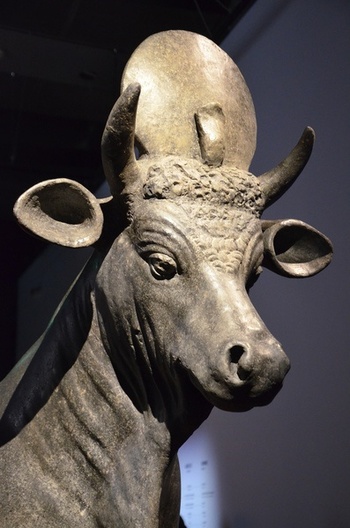
- Animal Motif: Cows, obviously.
𓃀𓋴𓄜 | Bes note
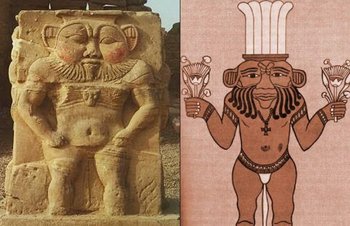
- Animal Motif: Ostriches. While the other gods get animal heads, Bes wears ostrich plumes.
- Canon Immigrant: His unusual design was often attributed to being an import to Egypt, but recent archaeological evidence suggests he's actually one of the oldest Egyptian gods.
- Gender Flip: Beset, his female counterpart/aspect.
- Hijacked by Jesus: Was likely Hijacked By Jesus to become Saint Bessus, venerated in northern Italy (they both wear ostrich plumes).
- Non-Standard Character Design: Portrayed as possessing an actual beard, rather than the false one of other Gods and Pharaohs.
𓄋𓈐𓏏𓏦𓃧 | Wepwawet/Upuaut/Wep-wawet/Wepawet/Ophois note

- Animal Motifs: Akin to Anubis, he is depicted as having a canine head. And like his brother, the actual species that is used for Wepwawet is debated- jackal, wolf (living or extinct), domestic dog, etc.
- Odd Job Gods: The god of opening the way.
- Palette Swap: In order to avoid confusion with Anubis, Wepwawet is drawn either bluish or grayish in color.
𓃀𓅡𓈒𓃀𓇌 | Babi/Baba note
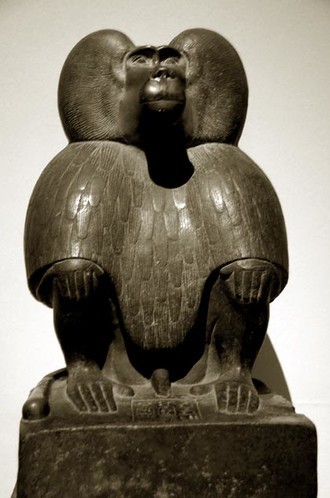
- Animal Motif: Like Thoth, he is associated with baboons.
- Amazing Technicolor Wildlife: One mural depicts him with a shaggy, cobalt blue coat.
- Ax-Crazy: Babi is feared for his behavior to attack mortals on sight.
- Gag Penis: He's always depicted with a visible erection, due to being associated with virility on account of male baboons having noticeably high libidos.
- Love God: With testicles large enough to sit on and a sturdy erection, it was sometimes symbolized as the mast of a ferry transporting the souls of the righteous to the fields of Aaru. One spell in a funerary text identifies the deceased person's phallus with Babi, ensuring that the deceased will be able to have sexual intercourse in the afterlife.
- Maniac Monkeys: He's the god of all African baboons. Angry, horny baboons.
- Soul Eating: Another legend says that when Ma'at sorts out the souls of the unrighteous, she hands them over to Babi, who devours them beside a lake of fire.
- To Serve Man: Truer than most baboons, which were known to be extremely aggressive and omnivorous, Babi was viewed as being very bloodthirsty and lived off of entrails of man.
𓇍𓅓𓊵𓏏𓊪/𓇍𓅓𓊵/𓇌𓅓𓊵 | Imhotep note
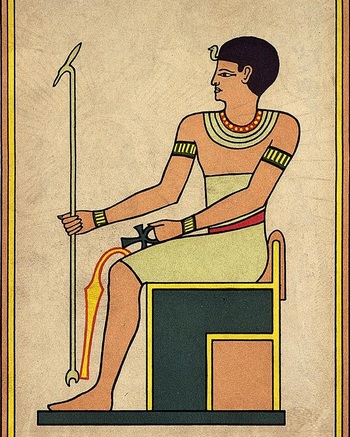
- Deity of Human Origin: Was a mortal human in his life, but after his death he was granted immortality and godhood.
- Renaissance Man: Scholar, chancellor, architect, doctor, mage and priest. He designed the first pyramid and the first known architect, engineer, and physician in recorded history. This makes him the Ur-Example of polymaths in general.
𓂕 | Nehebkau/Nehebu-Kau/Nehebkhau note

Nehebkau is a minor god that was once described as an evil spirit, but he was later depicted as a wise and benevolent figure that judges the dead and provides them with ka — a part of the soul that differentiates them from the living.
- Delightful Dragon: He's a snake with a pair on human legs, and he's a benevolent and protective deity that serves as one of the 42 wise judges of the dead and Ra's advisor, though older texts depicted him in a much less noble light.
- Heel–Face Turn: Nehebkau was once described as a malevolent spirit, then future texts depict him as a benevolent protector deity.
- Wise Serpent: Nehebkau is a snake with a pair of human legs, and his usual portrayal is that of a wise judge and royal counselor. The former comes from his role as one of the forty-two judges in Ma'at's Court (she's the goddess of truth) — the purpose being determining which deceased souls deserve entry to the afterlife and which are to be eaten by Apep. The latter comes from the fact he's Ra's (the Top God and solar deity) advisor. Due to syncretism, he's sometimes also a fierce but benevolent protector.
Demons, legendary beasts, spirits and miscellaneous creatures
𓉻𓊪𓊪𓆙 | Ἄποφις | Apep note

- 0% Approval Rating: Apep is hated and feared by every god out there. He is so terrible that even other chaos gods detest him, and he is the only deity in the Egyptian pantheon known to have been explicitly prayed against — every recovered prayer about him is about wishing for his hindrance and defeat. There was even an entire guide to opposing him, The Books of Overthrowing Apep, whose prayers described a gradual process of wishing for Apep's defeat and dismemberment.
- Adorable Abomination: Most likely unintentional, considering his reputation, but as the image above shows, Ancient Egyptian artwork of Apep makes him look surprisingly endearing for an evil chaos deity.
- Arch-Enemy: Ra, whom he tries to murder every night. Arguably Set as well, who has to fight him every night.
- Attack of the 50-Foot Whatever: One of his most notable characteristics is just how huge he was supposed to be. Pretty much every depiction that exists even has him
 ◊ coiled up in some way in order to emphasis this.
◊ coiled up in some way in order to emphasis this. - Big Bad: Of the whole mythos in general. Apep was the chief source of evil and chaos in ancient Egyptian cosmology.
- Cain and Abel: With Ra, in some myths. Apep was sometimes said to be Ra's twin brother from the same umbilical cord.
- Cessation of Existence: He inflicts this on those souls he devours.
- Chaos Is Evil: Explicitly described as a being of chaos, and Apep seeks the End of the World as We Know It.
- Dark Is Evil: He was explicitly called the god of darkness, which is a major component of his portfolio.
- Destroyer Deity: Apep is a primordial enemy who dislikes the other gods' creating and ordering of the universe and tries to devour Ra and all light & life every night to return the world back to its primordial chaos. Apep is sufficiently bad that Set, the notoriously ill-tempered and nasty god of chaos and storms (and a frequent "bad guy" in Egyptian myths), despises him and helps protect Ra against Apep every night. Apep is notably the only god in the Egyptian pantheon who was prayed against.
- Draconic Abomination: A huge Lovecraftian serpent that embodies death, darkness, and chaos.
- Dragons Are Demonic: A gigantic evil serpent who opposes the gods and wishes the absolute annihilation of all light and life in the universe.
- The Dreaded: So much so that he was the only deity actively prayed AGAINST, and that there were whole books dedicated to attacking and repelling him.
- Eaten Alive: Sometimes, during their fights, Apep would succeed in swallowing Ra whole, which would result in a solar eclipse. However, Ra would inevitably survive this, and break free from Apep's stomach once the eclipse ends.
- Eldritch Abomination: A primordial being born from Ra's umbilical cord that represents everything awful about the world. Also an Animalistic Abomination, since Apep is a being of chaos and destruction in the shape of a massive serpent, and no matter how many times Apep was slain, he always comes back.
- Evil Counterpart: To Ma'at, the Egyptian embodiment of Truth and Order.
- Evil Only Has to Win Once: Ra and Apep fight every night. Ra wins each time, but thanks to his Resurrective Immortality, Apep just comes back the next night to try again. Meanwhile, if Apep were to be victorious just once, he would annihilate the entire universe.
- God-Eating: Tries to eat Ra every night, and was believed to briefly succeed in eclipses.
- God of Chaos: Embodies chaos and destruction, in direct opposition to Ra and Ma'at.
- God of Evil: Actually a god who was unquestionably pure evil, and not worshiped at all.
- The Great Serpent: Possibly the Ur-Example. He was a massive snake monster that dwelled in the horizons and sought to devour Ra every day and night during his journey through the underworld.
- Hated by All: All the other gods (including Set) opposed him and mortals actively prayed against him.
- Hate Sink: Probably the oldest example of this trope. He's a loathsome deity who's defined by his malevolence and hatred for life. To put things in perspective, Apep was never prayed to by the Egyptians, only prayed against. Priests would even make icons of Apep just to step or spit on them.
- Hypnotic Eyes: Used this to lure the gods in before eating them. Only Set could resist it.
- Invincible Villain: There is a reason why Apophis earned the title of The Serpent of Rebirth. No matter how many times Ra destroyed Apophis, the evil snake god always comes back from The Underworld good as new, ready to destroy the universe again, and again, and again...
- Names to Run Away from Really Fast: A few of the titles given by people praying against him include Serpent From The West, Evil Lizard, Lord Of Chaos, The World Encircler, Bringer of Darkness, Devourer of the Sun, Enemy of Ra, and even, simply, "The Enemy." There is evidence to suggest he was also called Eater of Souls, though this title was not exclusive to him. A debatably subverted example would be his epithet Serpent of Rebirth, which without context sounds ambivalent if not pleasant.
- Never Smile at a Crocodile: Apep is sometimes depicted as a crocodile, and he's every bit as sinister as his original serpentine form.
- Non-Human Undead: A giant undead snake. Though some descriptions imply that it is an umbilical cord, specifically Ra's, that came to life.
- Non-Standard Character Design: Unlike other deities, Apep was was always depicted as a giant snake (sometimes even with legs) and never as a humanoid.
- Omnicidal Maniac: He sought to reduce the entire universe to a void by destroying all light and life in existence.
- Order Versus Chaos: Firmly on the chaos side, with Ra representing order.
- Our Dragons Are Different: This one's a gigantic snake that wants to eat the sun because he hates all life.
- Resurrective Immortality: Though Ra can slay Apep, this never sticks, and Apep comes back each night to try killing Ra again.
- The Scottish Trope: You weren't even supposed to say his name.
- Snakes Are Sinister: A malevolent being of chaos and darkness in the shape of a snake. Can't get any more evil than that.
- Soul Eating: Any souls who get lost on their way to the afterlife are also devoured by Apep.
- Super-Persistent Predator: Ra has to face him each night, kill him, and then face him again the next night for all eternity.
- The Undead: He lives in the land of the dead and therefore cannot be slain.
𓐥𓂧𓀭 | Medjed note

- "I know the name of that Smiter among them, who belongs to the House of Osiris, who shoots with his eye, yet is unseen."
- Adorable Abomination: If we are to take his visual appearance at face value, then he's a spirit who smites people that looks like a goofy Bedsheet Ghost.
- Armless Biped: Its depictions don't show it having arms.
- Bedsheet Ghost: Resembles this due to it being depicted without arms, a mouth, ears, nose, neck and even a proper torso. Whether this is how the Egyptians actually thought he looked like, or just their way of depicting the fact that he is unseen, remains unknown.
- Beware the Silly Ones: It may look absolutely ridiculous, but it's a harbinger of divine judgment with the ability to shoot laser beams out of its eyes.
- Eye Beams: One of the only things we actually know about him is that he "shoots with his eye".
- Eldritch Abomination: Seems to have been a rather alien deity, always being depicted shrouded in a veil and being the only being in Egyptian art always depicted facing the viewer.
- Only Known by Their Nickname: Possibly. Spell 17 begins with "I know the name of that Smiter", which implies that Medjed, which is just Egyptian for Smiter, may be a title rather than a name.
- The Spook: Medjed sees all but remains unseen, hence always being depicted covered by a veil.
Akhekh/Ākhekh/Akekhu

- Gruesome Goat: Well, Greusome Antelope, but you get the point. The Akhekh has the body of an oryx and associated with darkness and chaos, and is either a companion to or even an incarnation of Set. It certainly helped that the Ancient Egyptians actually did associate antelopes with Set and forces of chaos in the same way many associate goats with Satan and evil.
- Mix-and-Match Critters: Body of an Oryx, wings and beak of an eagle, with a serpent's tail for good measure.
- Our Gryphons Are Different: One source describes the Akhekh as having a lion's body as opposed to an oryx's, making it this trope. Even the normal form can be considered a kind of hippogriff what with the bird's head and wings on a hooved mammalian body.
𓂝𓅓𓄈𓅓𓏏𓏦𓀐 | Ammit/Ammut/Ahemait note
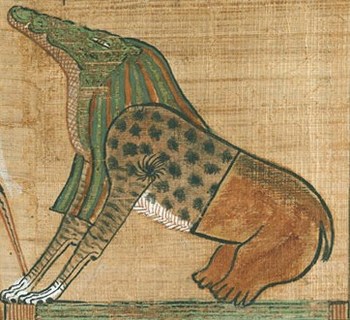
- Cessation of Existence: Souls eaten by Ammit simply cease to exist. This is considered a very bad thing by Egyptians, because existence is an important part of their religion.
- Female Monster Surprise: While it isn't obvious at first glance, the ancient texts state that Ammit is apparently female - understandable, given the behavior of female lions.
- Foil: To Tawaret. They are both goddesses with features of a hippo and crocodile. Where Tawaret gives life, Ammit takes it away.
- Mix-and-Match Critters: Has the head of a crocodile, the front limbs and torso of a lion, and the back limbs and rear end of a hippopotamus — all animals that the Egyptians rightly feared as the most dangerous on Earth.
- Our Demons Are Different: A beastly chimera that eats dead souls.
- Your Soul Is Mine!: Capable of eating the souls of the deceased.
𓊏𓊪𓀾𓋹𓈖𓐍 | Σφίγξ | Sphinx note
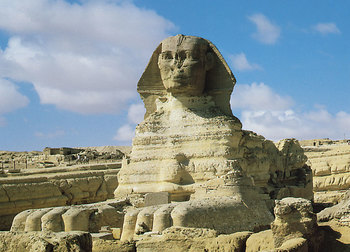
- Beast with a Human Face: The Androsphinx, which is the "default" species has a human head (mostly male).
- Mix-and-Match Critters: There are two alternate versions, the Hieracosphinx which has the head of a falcon (resembling a griffin/griffon) and the Criosphinx which has a ram head.
- Riddling Sphinx: Averted, as this is the Egyptian version.
- Time Abyss: According to new research, apparently it and the pyramids are from the Old Kingdom (circa 2558–2532 BC).
